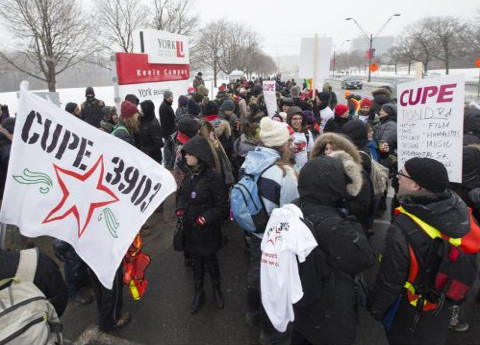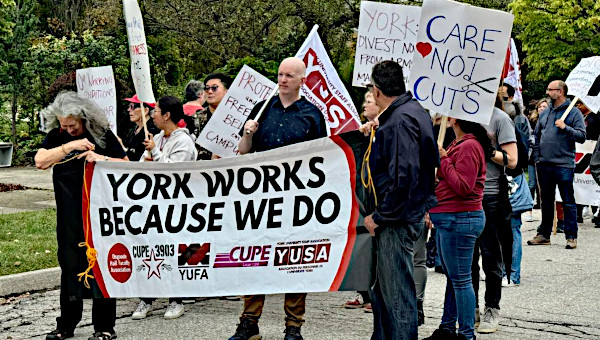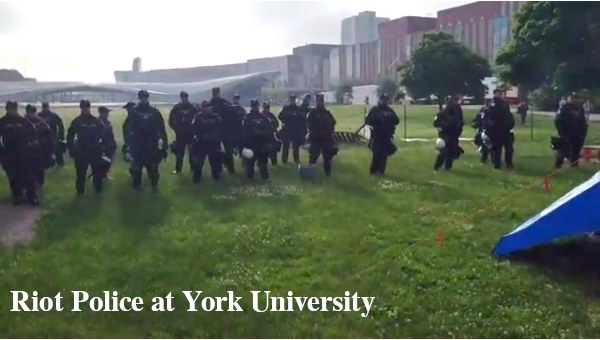The Neoliberal University: Looking at the York Strike
Placed neatly in the middle of a global economic maelstrom, it is near impossible to understand or predict what, if any, consequences the strike by 3500 odd teaching and research assistants and contract faculty at York University in Toronto (represented by Canadian Union of Public Employees Local 3903) will have for higher education in Ontario and throughout Canada. While there are some early indications that the strike – which began in early November and continues to shut down the university – at York is aiding (at least mildly) in negotiations at the University of Toronto (whose teaching assistants, research assistants and contract faculty are all presently in negotiations), the strike seems also to have engendered the anger and vitriol of the public such that the viability of similar strikes in the sector are in question. And while the tenor of the action was and remains pitched firmly at rolling back the “neoliberal university,” it is questionable whether even outright victory at York would or could have such far-reaching consequences across the university sector.
 Of course, there is only so much that can be accomplished in a single round of bargaining. Even if it may not yet be possible to outline how history will record the current work action, there are nonetheless some very definitive things that we can say about the particular conditions which have produced the strike of 2008. And we can also weigh and measure the degree to which the strike holds the promise of ameliorating those conditions (at York if not throughout the province), either temporarily or on a more lasting basis.
Of course, there is only so much that can be accomplished in a single round of bargaining. Even if it may not yet be possible to outline how history will record the current work action, there are nonetheless some very definitive things that we can say about the particular conditions which have produced the strike of 2008. And we can also weigh and measure the degree to which the strike holds the promise of ameliorating those conditions (at York if not throughout the province), either temporarily or on a more lasting basis.
The Political Economy of the Neoliberal University
It is simply not possible to understand the present labour conflict outside of some consideration of neoliberalism in general: the educative capacity of the state has been deployed in service of a program of accumulation that relies on a highly “flexploitable” and disciplined workforce. Out of the ashes of the Bretton Woods system, through a process of inter-class negotiation and conflict that neither put entirely to rest the practices of the Keynesian state, nor left any aspect of the postwar order entirely intact, a “new world order” built upon the flexibility of labour markets emerged in the 1980s. There is not sufficient space here to go over the details of this historical transition.
What needs to be understood, however, is that the crisis of Keynesianism, which was as much a political as an economic crisis, saw capital, and particularly a re-emergent finance capital, work with the capitalist state to respond to the crisis through a series of efforts that culminated in: (1) the complete transformation of the state apparatus and the state’s capacity to do things (i.e. in severe cutbacks to government spending on virtually everything including colleges and universities); (2) the acquiescence to such restructuring by the bulk of the population, and progressively; and (3) the emergence of broad based public support for the logic of “fiscal restraint” as well as for a program of economic growth premised on labour market flexibility, within which the neoliberal university factors very largely.
The neoliberal university began to take shape in the early 1970s, when hiring was frozen while tuition-fee and support generating enrollments were grown, as short-term stop-gaps to what were perceived as temporary fiscal cutbacks. Later, in the 1980s and 1990s, the neoliberal university began to take on more definitive dimensions, not because fiscal restrain had “hardened,” but because what amounted to a form of structural adjustment, drew increasing support from university administrators, an ever larger portion of the professoriate, and a good number of students as well. Thus, the neoliberal university has come to rapidly and rabidly pursue a closer articulation with industry and an educational methodology that focuses more on training than on educating.
Neoliberalism has involved “belt-tightening” and “fiscal restraint.” But its unfolding has also been underwritten by a more expansive logic than mere fiscal restraint could possibly entail. The university is now seen as a useful tool in the reproduction of a pliant working class and as a huge, publicly subsidized, research complex that can be deployed to further socialize the research costs of private capital accumulation and thus economic growth in its neoliberal form. In other words, through various forms of public-private partnerships, particularly at “research intensive” universities, private corporations can have taxpayers pick-up 90% of the costs associated with R&D, while they can maintain ownership over the bulk of whatever profits such research generates.
This kind of extensive logic is precisely why the neoliberal university is a massive and expansive morass of highly specialized departments, programs, research centres, laboratories and administrative offices, a huge and immensely diversified corporation with arms in almost every field of study. It is also why the fields of study themselves have become more cut-off from one another, even as we’ve seen the emergence of so many cross and sub-disciplines, like physical biology, or cultural studies, or urban and environmental planning (such growth makes meaningful forms of “interdisciplinarity” difficult to undertake).
This logic is also why the ideological scope within the neoliberal university is more limited than in previous eras. The space for critical scholarship has shrunk enormously in the social sciences. In part, this is a result of concerted efforts to purge so-called radicals (mainly from the right but also from the post-structural left), but in the main it is a result of state policies that either openly or tacitly endorse such an ideological closing, through conditional forms of finance. The neoliberal logic is also why much the same kind of ideological closing has happened in the natural sciences – there is increasingly less room devoted to basic and curiosity driven research because the drive to “research and innovate” favours the production of commercializable research and of intellectual and property rights.
The extensive logic of neoliberalism is even writ large spatially across the university, as university administrators, ever in search of new revenue-streams, offer-up any useful space to the signs and symbols of corporate accumulation. Buildings and classrooms are named after capitalists (and corporations) who have nothing whatever to do with scholarship, and even the bathroom stalls of the neoliberal university have become advertising opportunities.
Neoliberalism has also seen universities vie for precious market-share in large and growing national and international markets for higher-education. Each university is a competitor firm in the race to seize valuable customers from emerging economies ahead of competitor institutions. All of this has meant that the neoliberal university works hard to cultivate a brand, a particular kind of reputation, an orientation that potential customers understand will help them generate returns on their investments. The neoliberal university is also internally classed: a small cadre of elite academic “stars,” who are nonetheless terrifically over-worked, are offered high levels of academic and financial support, they enjoy relatively smaller teaching loads, social-status, and an ability to access some level of control within the institution. A much larger cadre of part-time and/or contract faculty are denied even basic – or any – perks, even as they undertake a terrific – and increasing – proportion of undergraduate teaching.
Not surprisingly, these changes have in turn required that the university become an expansive administrative bulwark with a large and growing cadre of career bureaucrats and administrators, many of whom move from university to university. There are also new kinds of offices opening up all the time, or old ones being re-branded as it were – from technology transfer offices to offices of research and innovation, to registrar cum customer-service departments, to in-house legal departments. The growth of this section of the university has been spectacular (squeezing down academic budgets while expanding general administration budgets). Students are en masse taking from the neoliberal university a general familiarity with the rigours of life under contemporary capitalism: an ability to understand and negotiate a large and expansive corporate environment, a sense of how to work the “system,” in the most instrumental way possible, as precisely that is what employers are looking for.
The Neoliberal University in Ontario:
Dynamics of Change at York
In as much as the last thirty years has seen successive provincial governments and a host of groups active within the sector provincially prepare a healthy number of reports and official studies, Ontario’s universities have not been the subject of very much scholarly work. This is surprising because, though there are some programmatic precursors, the transformation of Ontario’s post-secondary parallels so closely the trajectory of neoliberalism that it is a tremendously insightful and in many ways paradigmatic example of state restructuring.
Higher education in the province was, in the 1950s and early 1960s, a relatively small and elite endeavor. From the mid-to-late 1960s to the early 1970s, the system was completely revolutionized and massively expanded via public expansion. This expansion, during which total enrollments more than doubled, ended abruptly in the mid-1970s with the sharp economic downturn, which ultimately turned into the long restructuring leading to the neoliberalization of Ontario’s economy. By the mid-1980s, government transfers for student support (i.e. debt) were increasing, tuition-fees were rising, operating grants were progressively decreasing, and transfers for research were both mildly increasing and, more importantly, being linked in various ways to universities’ ability to attract private monies.
This trend accelerated through the 1990s and into the current decade (the Harris/Eves Tories gutted the Ontario Student Loan Program, but the McGuinty Liberals have since over-hauled and re-expanded the same). Funding cutbacks and conditional forms of financing have also always come neatly packaged with broader efforts to transform the normative landscape within and upon which universities operate.
Herein, we find sporadic discussion of what governmental reports call “differentiation” (i.e., the tiering of the universities in Ontario), rhetoric about the utility of having students and their families bear an ever greater share of the costs associated with post-secondary education (return on investment), and endless discussion of “quality” (capacity to deliver more high skilled professional workers for corporations). While every effort has been made to cleanse the language and legislation surrounding such issues of any connotation of conveyor belts and other industrial systems, the overall logic and drive is precisely that of a capitalist firm: to increase the throughput of the universities at a lower (for the government) unit cost and to socialize the costs of private capital accumulation.
To facilitate this program, Ontario’s government has built new institutions, imposed new regulatory requirements, established new standards, all at tremendous expense and all in an effort to prove that the cost-saving measures leveraged by universities pose no threat to educational quality (i.e. to build social consensus for the neoliberal university). Thus we find, for example, government mandated use of various testing and accountability practices, most of which never test things like literacy or critical thinking, but instead cast levels of throughput and/or student engagement as evidence of high-performance.
At York, an initial and rapid spate of growth during the final stages of growth of the Keynesian welfare state saw the institution amass a relatively young and politically progressive, and often radical, professoriate generally outside of the natural sciences. The relative cost of undertaking “intensive” (i.e. very expensive) forms of research in the natural sciences as well as York’s proximity to the University of Toronto (UofT), which had long been Canada’s largest and most research intensive institution, meant that the social sciences and humanities burgeoned while the growth of the natural sciences remained somewhat retarded. When transfers to universities were cut in the mid-to-late 1970s, York’s modus operandi presented some challenges, mostly because it did not have the ability, as did the older more research intensive institutions, to increase what the government calls “own-source income” (i.e. private research contracts and donations).
York therefore did – and has continued to do – what many other institutions did: it sought to grow enrollments without parallel increases to its complement of full-time and tenured faculty. By, on the one hand, growing enrollments and, on the other hand, leveraging an ever larger number of part-time contract faculty to teach, York sought to maintain some level of financial stability. In the mid-1980s, when both levels of government began to channel funds to intensive and commercializable research in the natural sciences and engineering, York’s administration began in earnest to cultivate and grow its capacity in those areas and also develop speculative plans to open a medical school. Such efforts have often leveraged enrollment growth in the social sciences and humanities as a cash cow and contract faculty as a cost-savings device. In other words, strip academic funding for Arts and Humanities via completely internally fabricated accounting deficits justifying yearly budget and course cuts, have the remaining courses taught by part-time faculty in increasingly crowded classrooms, and transfer these moneys to ever-expanding administrative budgets and to cross-fund to expand other more capital-intensive and expensive programmes (all of which are a further burden on university funds through time).
York has also developed all of the other hallmarks of the neoliberal university. It has developed more in-house legal capacity; established an office of research and innovation; come out as a strong supporter of tests that measure “student engagement” as an indication of academic quality. York has substantively closed, or at best utterly transformed its once progressive school for continuing education into a high-volume student “sausage” factory of questionable academic quality. And it has pursued enrollment growth at all cost to become larger than all but one other university in Canada.
At the same time, York’s Administration has also looked to overcome its historical branding as the home of so many critical scholars of contemporary society and capitalism. It has done so not by buying labour peace, but by cultivating strategic relationships with well-disposed faculty in and around the university’s various governing bodies, by designing award winning advertising campaigns, and by pushing its campus teaching unions to strike in the hopes of ultimately breaking and then domesticating them. While this has clearly produced significant moments of labour discord with York’s teaching staff, there is reason to think that it may ultimately produce a more pliant and agreeable labour force and professoriate. As the social sciences and humanities are both transformed and rationalized, and as the sciences are expanded (the sciences have traditionally been relatively open to neoliberal type funding and enrollment growth), it may well come to pass that the faculty and graduate student populations are both transformed and de-mobilized.
Moreover, the York Administration’s very tactical and anti-union game has generated some impressive results. Though the Administration has, often after long and needlessly drawn out labour disputes, wound up signing some of the most progressive collective agreements in the Canada, let alone Ontario, it has also succeeded in stepping out of the shadow of the UofT. As one Toronto Star reporter put it; York has succeeded in building a highly renowned business school, a similarly reputed law school, and is knee-deep in various other commercially oriented projects, like YORKBiotech, which have seen massive increases to its ability to generate “own-source income.”
As well, York has been able to grow enrollments twice as fast as it has increased the faculty complement, again largely by offsetting low numbers of full-time faculty, with ever higher numbers of contract faculty. And in an environment where such cost-saving tactics are looked kindly upon by the provincial authorities, their administrative counterparts, as well as much of the mainstream, York has been able to shed some of its “radical school” baggage. Indeed, as “quality” has come to be understood as either productivity, or some proxy for pliancy (i.e. a well trained but poorly educated workforce), York is truly blazing a well-traveled, but nonetheless rather coveted (among university administrators) path.
The Teaching Assistant and Contract Faculty Strike
Not at all surprisingly, the tolerance of graduate and teaching assistants as well as contract faculty for this modus operandi is limited. Graduate students, who most frequently work as teaching assistants, often managing classes of 30 or 40 on their own, have watched as support funds have been reduced by enrollment growth. They have seen university administrators enjoy salary increases that are more aggressive and generous than anything available in the private sector, and anything being gained by support staff, TA’s or faculty. They have been forced to wait patiently as their over-burdened faculty deal with more and more students; and they have been forced perennially to swallow nonsense about their relative wealth when their annual income, after tuition-fees are deducted, hovers around $12,500.
Similarly, contract faculty has been forced to bear much of the brunt of York’s restructuring. Relatively low wages mean that contract faculty must stitch together numerous contracts. They must reapply for teaching assignments every four or eight months. As there is great uncertainty in these teaching allocations, they thereby take on incredibly intense teaching loads. Of course, such conditions are endemic throughout the Canadian university system: York, to be sure, is hardly an exception. York is different, however, in so far as it has had to travel relatively far to become a highly reputed neoliberal university. The York University Administration, therefore, across several university Presidents, has necessarily pursued its accent into the mainstream with vigour and lust, if only because they have seen no other way, given the university’s starting position in the Arts and Humanities.
York’s strike, therefore, more than many other strikes, represents a kind fissure that allows us to see clearly the dark underbelly of higher education in Ontario, after decades of chronic underfunding by the neoliberal policies of the Canadian state.
The chasm that presently exists between the two parties concerns primarily three issues, all of which speak directly to the central underpinning of the neoliberal university. These are: sub-poverty wages of graduate students that are clawed back through tuition-fee grabs; support funds for graduate education that are depleted through rapid enrollment growth; and contingent, precarious work for which long serving contractors must constantly reapply. These work conditions keep part-time university workers in a sufficiently precarious but manageable condition that work stoppages and oppositional movements are either infrequent or sufficiently fragmented that they can be overcome. If addressed to the extent that CUPE 3903 is presently asking, none of these conditions will be entirely corrected – long-serving contractors will enjoy some modicum of security and a better standard of living, graduate students will be slightly less pressed to find other sources of income, take-on large amounts of debt, or sweat it out under less than reasonable circumstances. But little will be done to correct York’s now long-running dependence on flexible labour, or its ability to pursue further neoliberal type restructuring.
These are not problems that a single round of bargaining can hope to fully address and redress. As Dan Crow’s article (in Bullet #160) suggests, CUPE 3903’s ability to secure a two-year contract and participate in coordinated bargaining with other part-time university workers throughout the province holds more potential than any single round of bargaining ever could. This is also where the social justice issues for graduate students are just as strong, and the problems of precarious work for contract faculty even more extreme. And it is where sector-wide issues of the neoliberal university in Ontario – one of the most underfunded university systems in Canada – need to be confronted.
Whatever the outcome, though, we would do well to watch and learn from the current labour conflict at York University. The consistent protestations of the York Administration about a souring global economy as an excuse to avoid offering higher wages and job security, combined with the degree to which such excuses seem to have achieved the sympathy of the public at large, are reminiscent of similar such excuses used with some effect at the onset of neoliberalism some thirty odd years ago. They are also indicative of the obstacles progressive forces must now overcome. •





